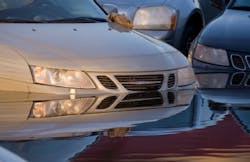Jose Villarreal was already well versed in how to handle total loss situations prior to the summer of 2017.
Then, Hurricane Harvey hit.
All of a sudden, Villarreal’s workplace, Mac Haik Ford in Houston, was inundated with customers with water-logged vehicles and dashboards that were too saturated to be salvaged. In the wake of the costly tropical storm, Villarreal, the dealership’s collision center director, dealt with 120 totaled vehicles in the span of three weeks.
“Pretty much half the town had to buy a new car, or another car,” Villarreal says. “Pretty much every car that was coming in here was a total loss, because the water levels were so high.”
Yet, the collision center director kept his stress levels reasonably low. After all, his facility, which boasts a 94.8 percent CSI rating, was already used to dealing with 20–25 totals per month. So, Villarreal typically passed those customers who were affected by the historic storm on to his dealership’s sales people, fueling several new-vehicle purchases.
In the wake of Harvey, Villarreal has rare knowledge of how to smoothly handle a customer’s total loss. And, in a recent conversation with Fixed Ops Business, the industry veteran shared tips for how to handle totals, which have increased significantly throughout the industry since 2000 (spiking from 9 percent of all claims to 20 percent by 2015, according to CCC Information Services), due in large part to the cost of evolving vehicle technology.
Usually, when a car comes in that’s hit really hard, of course we ask, “Is everyone OK? Hopefully nobody got hurt.” We’ll let them know, “The damage is pretty severe on your vehicle, and the insurance company is the one that determines it’s a total, not us. Depending on the value of your car, that’ll make the decision whether your car is fixable or not.” Initially we let them know it could possibly be a total, so they can kind of start planning in their mind what their next step might be. Then, we give them their options—that they can either let the vehicle go, they can keep it and fix it, or they can keep the money and sell it outright.
We let the insurance company contact customers first, when the car is an official total. Then they call us. We’ll have a genuine conversation with a customer, explaining to them that sometimes insurance companies will give you a lower value on your car, and we recommend that customers don’t accept the first offer they give you, and always try to push for more money. And that’s when we’ll ask, “Are you going to be looking for another vehicle? Is there any way we can assist you? Could I have my sales department call you?” We try to make a smooth transition, where they don’t feel like they’re being pushed. We’ll probably talk to them five total times over the course of about a week and a half.
The biggest key is treating the customer genuinely, and making sure you’re assessing all their needs. Sometimes customers come in and that car is their baby, and you’ve got to treat them with more care, because that was their favorite Mustang or whatever. But, sometimes customers come in here and they couldn’t care less about their totaled car; those customers are just looking for a solution right away. We say, “OK, we can have a sales guy call you immediately and put you in another car that you can be driving tonight.” And, there are some that take longer, where customers want to talk about it for a whole week, about what their options are. If you treat them right and are genuine, that goes a long way, because then they know you’re not blowing smoke.
We try to flip an off-brand customer if we can. We try to sell the features of the dealership—the sales department, our service department and all of that—everything we offer. I would say we flip about 50 percent of the off-brand customers. Because, usually, when customers are here already, we can say, “While you’re here, would you like to see our sales department, and see what they have to offer?” Then, they wouldn’t have to go to another dealership and go through all the steps again. That’s the best way to do it—to establish trust first. And, we have a go-to salesman up front that’s kind of associated with the body shop to whom we usually send customers with totaled vehicles.
We have a spiff plan for our estimators for getting a total loss customer to buy a car. It’s typically called a “bird-dog fee”—if a customer buys a car, there’s a bonus that reimburses the estimator and pays them for their efforts. I think it’s very important for dealerships to do that, because it incentivizes the estimator to not just blow off the total loss customer. That helps out tremendously.

